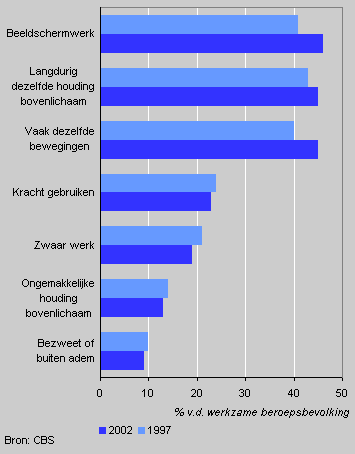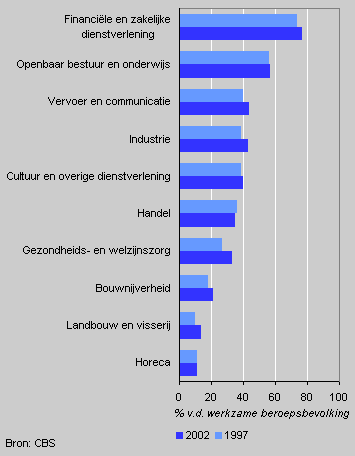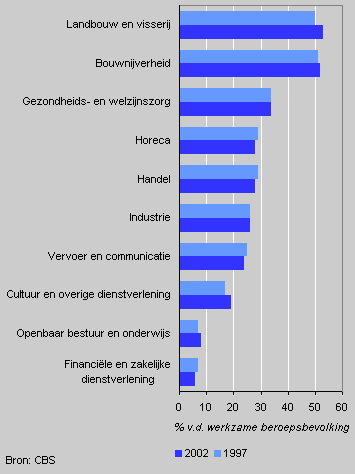More people work with computers

The nature of paid labour in the Netherlands has changed gradually in the period between 1997 and 2002. Work that was becoming more popular in 1997, such as work at personal computers, has increased further, while work that was less common in 1997, such as lifting, pushing, dragging, pulling and other work requiring physical effort has hardly increased at all.
Labour by physical workload

More than 3 million PC workers
In 2002 more than 3 million workers in the Netherlands regularly worked with a PC. This is 46 percent of the employed labour force, more than 5 percent points up on 1997.
About the same share of people do work in which they have to retain the same posture for long periods of times or make regularly repetitive movements (such as working at a conveyor belt).
Just over 1.6 million people (23 percent) have to use physical strength on a regular basis. This percentage is about the same as in 1997. More than 1.3 million workers (19 percent) find their work heavy in physical terms. This percentage, too, has hardly changed since 1997.
PC work by sector of industry

Most PC work in services
More than three-quarters of workers in the services sector work at a PC on a regular basis. This is 3 percent points more than in 1997. In the government and education sectors 57 percent of employees worked with computers in 2002 about the same number as in 1997.
Fewer than 15 percent of people working in the hotels and restaurant sector and in agriculture and fishery regularly use a computer. Computer use rose by 4 percent points in the latter sector. In the hotel and restaurant sector it did not increase at all.
The largest increase in PC work between 1997 and 2002 (6 percent points) was in health care and welfare.
Use of physical strength by sector of industry

Physical effort
On average, one in four workers had to use physical strength in their work, for example to lift, push and pull. This is the same proportion as in 1997. More than half of workers in agriculture, fishery and construction regularly use physical strength. In the health care and welfare sector this is the case for more than one third of workers. Across all sectors of industry the proportion of workers who have to use physical strength regularly hardly changed between 1997 and 2002.
Physical complaints
Eight out of ten workers are subjected to some form of physical workload. Of these eight, 44 percent suffered from pain in their back, neck, shoulder or arms. As a consequence of these complaints, 37 percent visited their GP and 20 percent were so ill that they missed work.
Christianne Hupkens